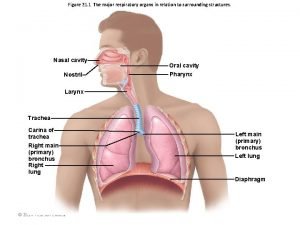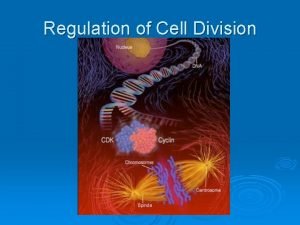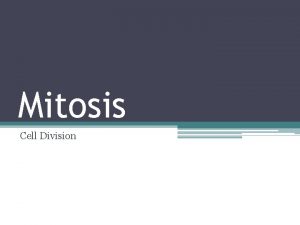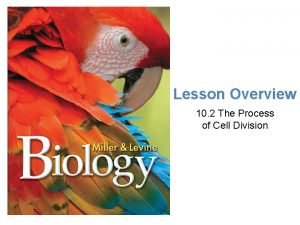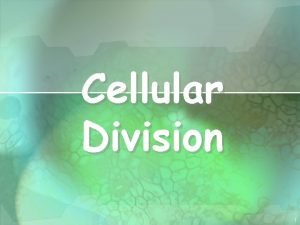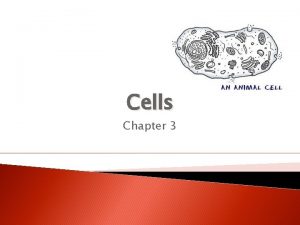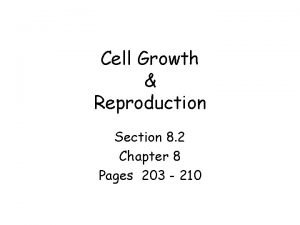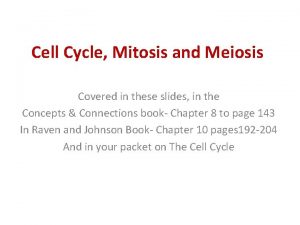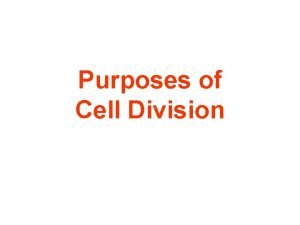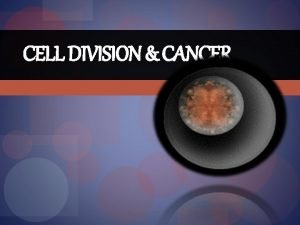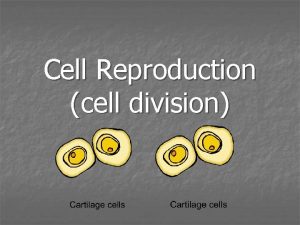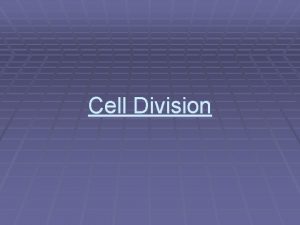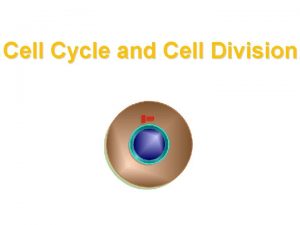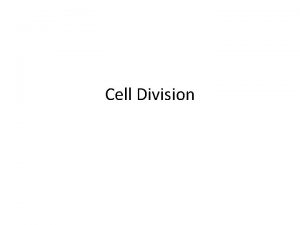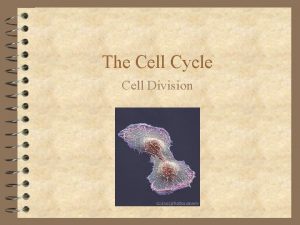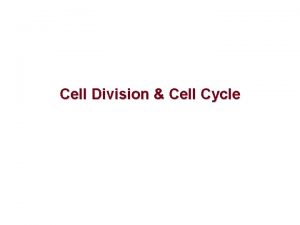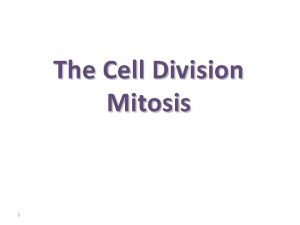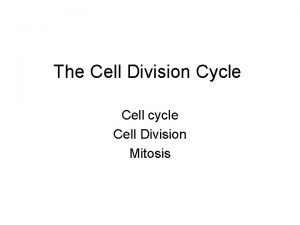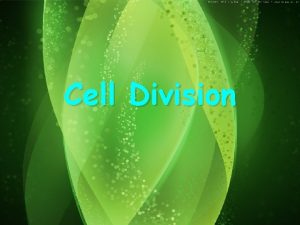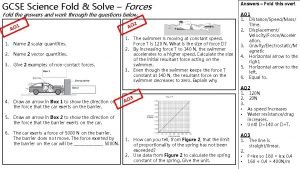Purposes of Cell Division fold Purposes of C






















- Slides: 22

Purposes of Cell Division

fold Purposes of C e l l D i v i s i o n cut in Humans

Purpose #1 - Reproduction Cell division for reproduction creates offspring with traits from both mother and father.

Dad Mom A very unhappy baby.

Traits- Red hair from dad, curly hair from mom

Why it’s important: If offspring are created, the species continues. If not, the species becomes extinct. Reproduction makes Called: MEIOSIS

What is Meiosis? • A special kind of cell division that creates sperm and egg cells which have ½ of the normal number of chromosomes. In humans- 23. (Note: the normal number is 46)

The “daughter cells” created in males are sperm cells The “daughter cells” in females are egg cells.

MOM egg DAD egg ½ chromosomes from Mom offspring sperm ½ chromosomes from Dad (reproduction)

Purpose #2: After the organism is “born” Growth, Repair & Development Cell division for growth , repair and development creates exact copies of a cell.

Why it’s important: Makes it possible for living things to grow (increase in size and mass); repair itself (create new cells to replace damaged or dead cells, and to develop (mature/pass on traits).

Development • … is defined as “a process in which an organism changes itself from a single cell into a more complicated multicellular organism. ” Occurs following fertilization.

Why it’s important: Makes it possible for an organism to mature into adulthood. The adult organism can eventually reproduce and continue the family line.

Growth vs Development • How big or massive an organism is • When an organism grows, it also develops, but only in terms of increasing its size and mass. • A change from being a single cell to a more complex multi-cellular organism. • Involves the organism’s structure, abilities etc.

Growth, Repair & Development result from a type of cell division called: MITOSIS

What is mitosis? Mitosis is the type of cell division in which 2 cells are created from each cell that divides. These two cells are called “daughter cells”.

What is mitosis? Daughter cells are identical to the cells that created them (parent cells). This allows for cell specialization. One example: the production of skin cells.

Skin Cell Chromosomes make copies Half go to each new cell Skin Cell exact copies (growth & repair)

Mitosis: • Occurs wherever more cells are needed. • Chromosomes are copied within the nucleus, then the cell divides creating two daughter cells that are identical to the parent cell.

Mitosis Summary Mitosis is cell division that plays an important role in the growth, repair and development of our bodies starting at conception and continues throughout our lives. Cells produced by mitosis are identical to the cell that created them and are specialized.

Quick Quiz: 1. Meiosis makes __________. 2. The purpose of meiosis is _______. 3. Meiosis create egg and sperm cells with _____ the original chromosomes. 4. Egg and sperm combine to create an _____ with unique traits. 5. Cells created by mitosis are _______ meaning they have specific functions. 6. Mitosis makes an exact ______ of the original cell. 7. The purpose of mitosis is ____, _______ and ________ of organisms.

me, sperm & egg cells 1. Meiosis makes _____. 2. The purpose of meiosis is _______. reproduction 3. Meiosis create egg and sperm cells with _____ the half original chromosomes. offspring 4. Egg and sperm combine to create an _____ with unique traits. specialized 5. Cells created by mitosis are _______ meaning they have specific functions. 6. Mitosis makes an exact ______ of the original cell. copy growth repair 7. The purpose of mitosis is ____, _______ and development _______ of organisms.
 Thyroid cartilage
Thyroid cartilage Respiratory
Respiratory Events of the cell cycle
Events of the cell cycle Cell cycle and cell division
Cell cycle and cell division Cell cycle phases in order
Cell cycle phases in order Article 1 section 1 national territory
Article 1 section 1 national territory Long division and short division
Long division and short division What is synthetic division
What is synthetic division H.c.f
H.c.f 6-5 dividing polynomials answer key
6-5 dividing polynomials answer key Mitosis pmat diagram
Mitosis pmat diagram Frequency of cell division
Frequency of cell division Concept map of mitosis
Concept map of mitosis Interphase of cell cycle
Interphase of cell cycle What happens in prophase
What happens in prophase Cell division acronym
Cell division acronym When is a tetrad formed
When is a tetrad formed A sticky semi fluid material found
A sticky semi fluid material found Section 8-2 cell division
Section 8-2 cell division Mitosis sexual reproduction
Mitosis sexual reproduction Mitosis and meiosis
Mitosis and meiosis Cell furrow method
Cell furrow method Metaphase plate
Metaphase plate

